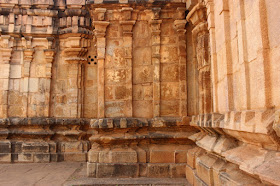February 18, 2020
My main work for the day was to take Pushpa to Hubli for her exam, it was the last paper. The exam center was walking distance from Siddharoodha Mataha. I parked my car at the Matha's parking lot, we had breakfast together and walked with them to the exam center which was about half kilometer away. Now I had three hours to spend. My plan was to visit a Trikutachala temple in old Hubli and Moorusavira Matha. I didn't want to drive in the narrow streets of old Hubli, planned to hire a rickshaw. I walked back to Siddharoodha Matha, found a rickshaw stand. I struck a deal with a rickshaw guy for a round trip. The rickshaw guy's name was Lava, he belonged to Patheghar community. Nice person. He was familiar with the temple, reached our destination easily. This is the Trikutachala's only entrance. The temple's original front yard was much below, it had steps at the entrance. The road level has been raised so high that the temple floor is below road level. The person standing at the entrance is the head priest of this temple.
I guess this hall can be called the Sabhamantapa ~ meeting hall. These are original material after treatment, probably sandblasting and water-wash. The steel grills are an eyesore but necessary to keep out vandals. The priest has done done a good job a caretaker of this temple.
The columns, beams, walls, roof and floor are all made of sandstone. This stone is available easily in these parts. The architecture is no doubt Chalukyan. The columns are simple but well made. The midsection of the column is interesting.. looks like a stack of torus. Torus is defined as a solid formed by rotating a closed curve, especially a circle, about a line which lies in the same plane but does not intersect it (e.g. like a ring doughnut). I really can't remember seeing this type of column anywhere else.
A door connects this hall to another hall which has four turned pillars of granite. Granite is much harder compared to soapstone. Granite can be polished to mirror finish but not with soapstone. These four pillars form a central Mantapa, its floor is slightly raised from its surrounding. I guess this hall can be called Nritya Mantapa. Stright ahead is the east-facing Garbhagriha which houses the deity of Sri Bhavani Shankar, a form of Lord Shiva. A small idol of Nandi sits in the Antarala ~ vestibule connecting the Nritya Mantapa and Garbhagudi.
Even though the temple looks plains i.e. the absence of grand artwork, basic requirements have been taken care of. For example- the multiple layers of door frame and floral art on the floor at the Garbhagudi entrance.
The south-facing Garbhagudi is occupied by a beautiful idol of Sriman Narayana. The idol seems to be of Hoysala period. The four-armed idol features Chakra, Shankha, Gada and Pani. At his feet is Anjaneya. At the crest of the idol is a Kirtimukha.
In the passage connecting the south-facing Garbhagudi and Nritya Mantapa is an idol of Saptamatrikas.
On the other side is a pedestal with an idol of serpent god and a pair of feet. I think this is the priest's relative performing a ritual. Not sure who the feet represents. Since a pooja was being performed, I did not want to intrude it any longer, decided to step out and check the exterior.
The temple has some open space on the northern and western sides. These walls and Shikhara form Narayana's Garbhagudi. The walls are also quite plain except for the miniature columns. The flag atop the Shikhara is a nice touch, the fluttering saffron triangle makes gives a lively feeling.
This is the rear of the temple. On the right is the main Garbhgudi i.e. the east-facing one.
This is the Shikhara of the south-facing Gabhagudi where the idol of Narayana is seen. The horizontal protrusion to the right is an interesting feature which is quite common in Chalukyan architecture.
This picture has been included in this post for the sake of a ventilator with small circular openings. I did not notice it when I was inside. Probably the openings had been covered. On the opposite, there's another ventilator with square holes.
Shikhara on the east-facing Garbhagudi. I think this temple features Vimana Nagari Shikharas.
The ventilator between north-facing Garbhagudi and east-facing Garbhagudi. The column seen here seems has lost quite a bit of material, wondering if the erosion was natural.
Behind the north-facing Garbhagudi is a 3' tall column. One cans see such stubby pillars in many a temple but not sure of its function.
Shikhara over the north-facing Garbhagudi. The form of these Shikharas is designed to draw cosmic energy. Why should the Shikara be so complicated? Why not a plain one? Our ancient builders actions were based on meaningful theories and experiences. Their knowledge is beyond the glance, grasp of modern day people. May be there are few scientists who have some clue about ancient technologies.
On these Shikharas, the bottom layer has Kirtikumkhas. The function of Kirtimukha is to ward of evil eyes?
On the left is my rickshaw guy Lava and on the right is the priest's nephew. The temple visit was nice, we said bye to the priest and his nephew. Before we left, we were asked to visit Sri Dattatreya Devastana, a stones throw from here. It is said that the Chakra in the Shikhara has magical powers.
The main gate of Dattatreya temple was open but the Garbhagudi was closed. We paid respects from the outside and moved towards Moorusavira Matha.
.........

















I continue to enjoy your blog so much.
ReplyDeletethank you Alexis :)
ReplyDelete